Netflix Business Strategies and Innovation
VerifiedAdded on 2020/05/28
|18
|4394
|479
AI Summary
This assignment delves into the multifaceted business strategies employed by Netflix. Students are tasked with examining the company's recommender system algorithms, their contribution to business value, and the innovative approaches that have propelled Netflix to the forefront of the entertainment industry. The analysis should encompass aspects such as pricing models, content acquisition strategies, and the impact of technological advancements on Netflix's operations.
Contribute Materials
Your contribution can guide someone’s learning journey. Share your
documents today.
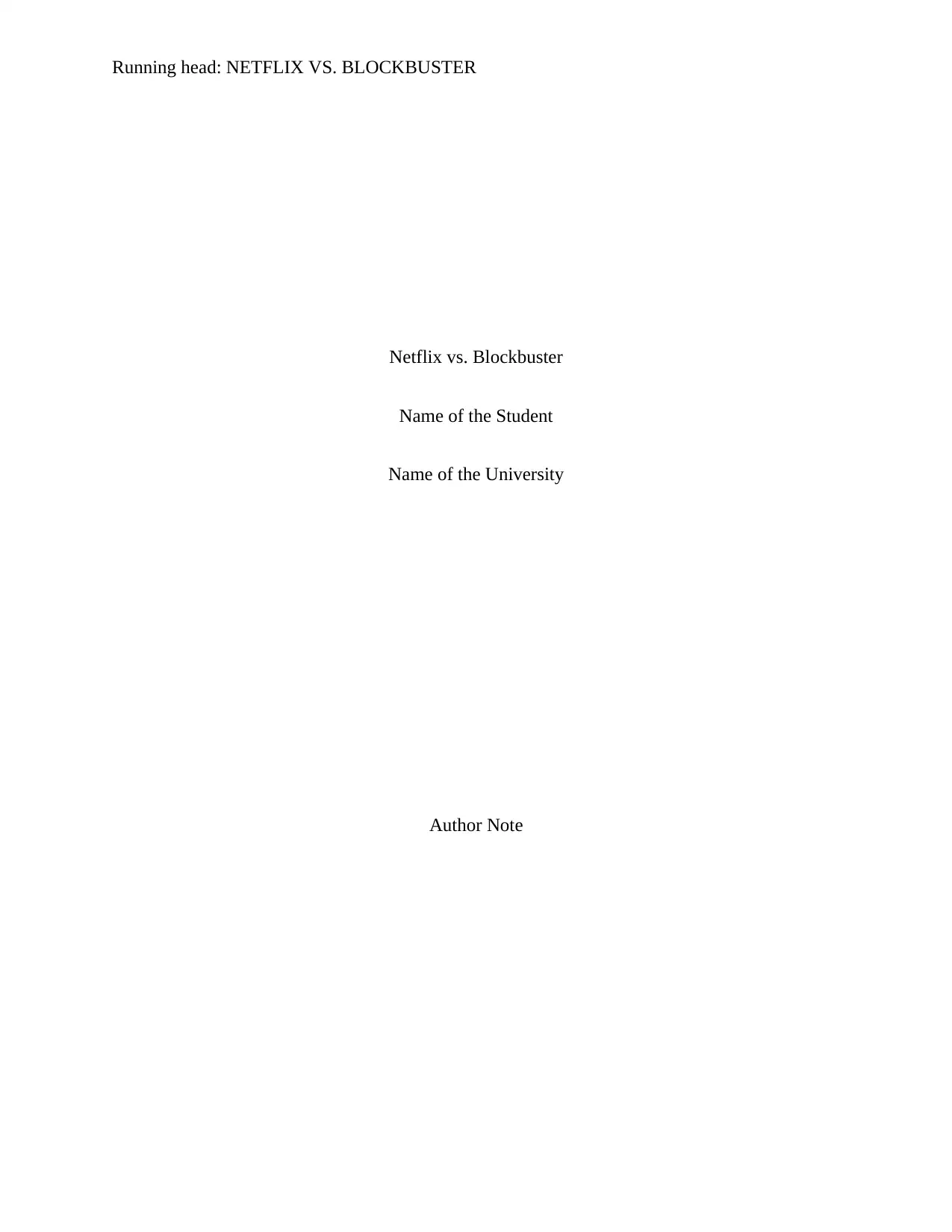
Running head: NETFLIX VS. BLOCKBUSTER
Netflix vs. Blockbuster
Name of the Student
Name of the University
Author Note
Netflix vs. Blockbuster
Name of the Student
Name of the University
Author Note
Secure Best Marks with AI Grader
Need help grading? Try our AI Grader for instant feedback on your assignments.
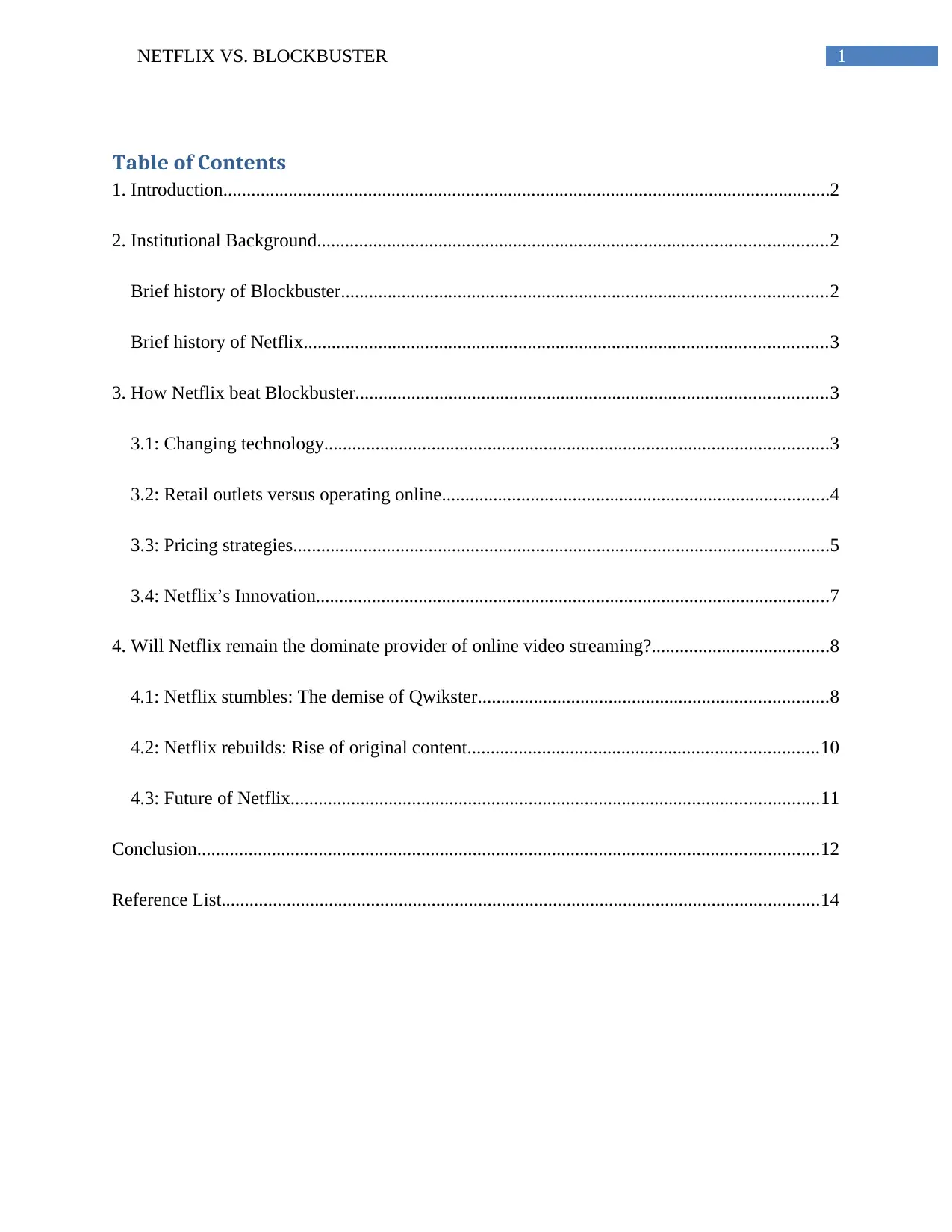
1NETFLIX VS. BLOCKBUSTER
Table of Contents
1. Introduction..................................................................................................................................2
2. Institutional Background.............................................................................................................2
Brief history of Blockbuster........................................................................................................2
Brief history of Netflix................................................................................................................3
3. How Netflix beat Blockbuster.....................................................................................................3
3.1: Changing technology............................................................................................................3
3.2: Retail outlets versus operating online...................................................................................4
3.3: Pricing strategies...................................................................................................................5
3.4: Netflix’s Innovation..............................................................................................................7
4. Will Netflix remain the dominate provider of online video streaming?......................................8
4.1: Netflix stumbles: The demise of Qwikster...........................................................................8
4.2: Netflix rebuilds: Rise of original content...........................................................................10
4.3: Future of Netflix.................................................................................................................11
Conclusion.....................................................................................................................................12
Reference List................................................................................................................................14
Table of Contents
1. Introduction..................................................................................................................................2
2. Institutional Background.............................................................................................................2
Brief history of Blockbuster........................................................................................................2
Brief history of Netflix................................................................................................................3
3. How Netflix beat Blockbuster.....................................................................................................3
3.1: Changing technology............................................................................................................3
3.2: Retail outlets versus operating online...................................................................................4
3.3: Pricing strategies...................................................................................................................5
3.4: Netflix’s Innovation..............................................................................................................7
4. Will Netflix remain the dominate provider of online video streaming?......................................8
4.1: Netflix stumbles: The demise of Qwikster...........................................................................8
4.2: Netflix rebuilds: Rise of original content...........................................................................10
4.3: Future of Netflix.................................................................................................................11
Conclusion.....................................................................................................................................12
Reference List................................................................................................................................14
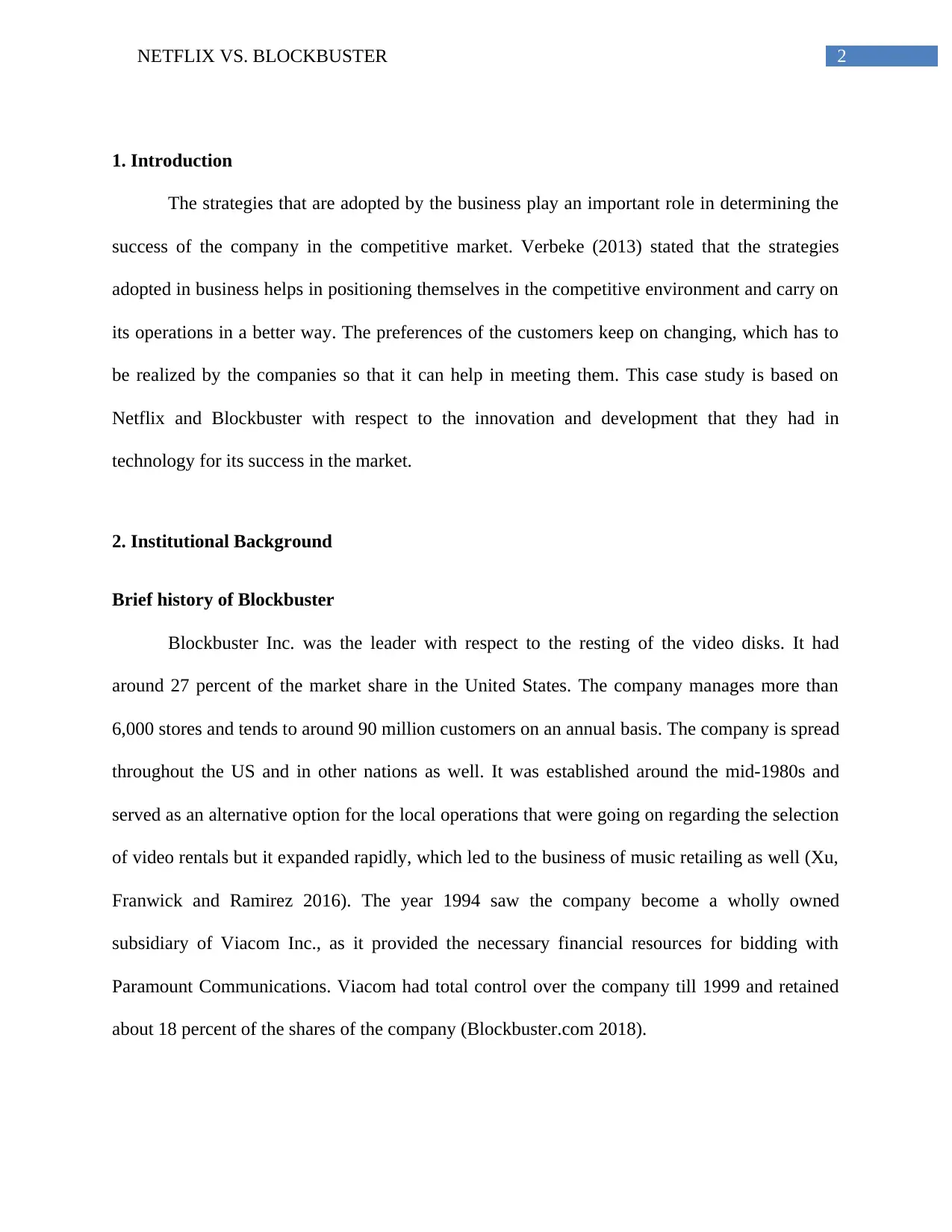
2NETFLIX VS. BLOCKBUSTER
1. Introduction
The strategies that are adopted by the business play an important role in determining the
success of the company in the competitive market. Verbeke (2013) stated that the strategies
adopted in business helps in positioning themselves in the competitive environment and carry on
its operations in a better way. The preferences of the customers keep on changing, which has to
be realized by the companies so that it can help in meeting them. This case study is based on
Netflix and Blockbuster with respect to the innovation and development that they had in
technology for its success in the market.
2. Institutional Background
Brief history of Blockbuster
Blockbuster Inc. was the leader with respect to the resting of the video disks. It had
around 27 percent of the market share in the United States. The company manages more than
6,000 stores and tends to around 90 million customers on an annual basis. The company is spread
throughout the US and in other nations as well. It was established around the mid-1980s and
served as an alternative option for the local operations that were going on regarding the selection
of video rentals but it expanded rapidly, which led to the business of music retailing as well (Xu,
Franwick and Ramirez 2016). The year 1994 saw the company become a wholly owned
subsidiary of Viacom Inc., as it provided the necessary financial resources for bidding with
Paramount Communications. Viacom had total control over the company till 1999 and retained
about 18 percent of the shares of the company (Blockbuster.com 2018).
1. Introduction
The strategies that are adopted by the business play an important role in determining the
success of the company in the competitive market. Verbeke (2013) stated that the strategies
adopted in business helps in positioning themselves in the competitive environment and carry on
its operations in a better way. The preferences of the customers keep on changing, which has to
be realized by the companies so that it can help in meeting them. This case study is based on
Netflix and Blockbuster with respect to the innovation and development that they had in
technology for its success in the market.
2. Institutional Background
Brief history of Blockbuster
Blockbuster Inc. was the leader with respect to the resting of the video disks. It had
around 27 percent of the market share in the United States. The company manages more than
6,000 stores and tends to around 90 million customers on an annual basis. The company is spread
throughout the US and in other nations as well. It was established around the mid-1980s and
served as an alternative option for the local operations that were going on regarding the selection
of video rentals but it expanded rapidly, which led to the business of music retailing as well (Xu,
Franwick and Ramirez 2016). The year 1994 saw the company become a wholly owned
subsidiary of Viacom Inc., as it provided the necessary financial resources for bidding with
Paramount Communications. Viacom had total control over the company till 1999 and retained
about 18 percent of the shares of the company (Blockbuster.com 2018).
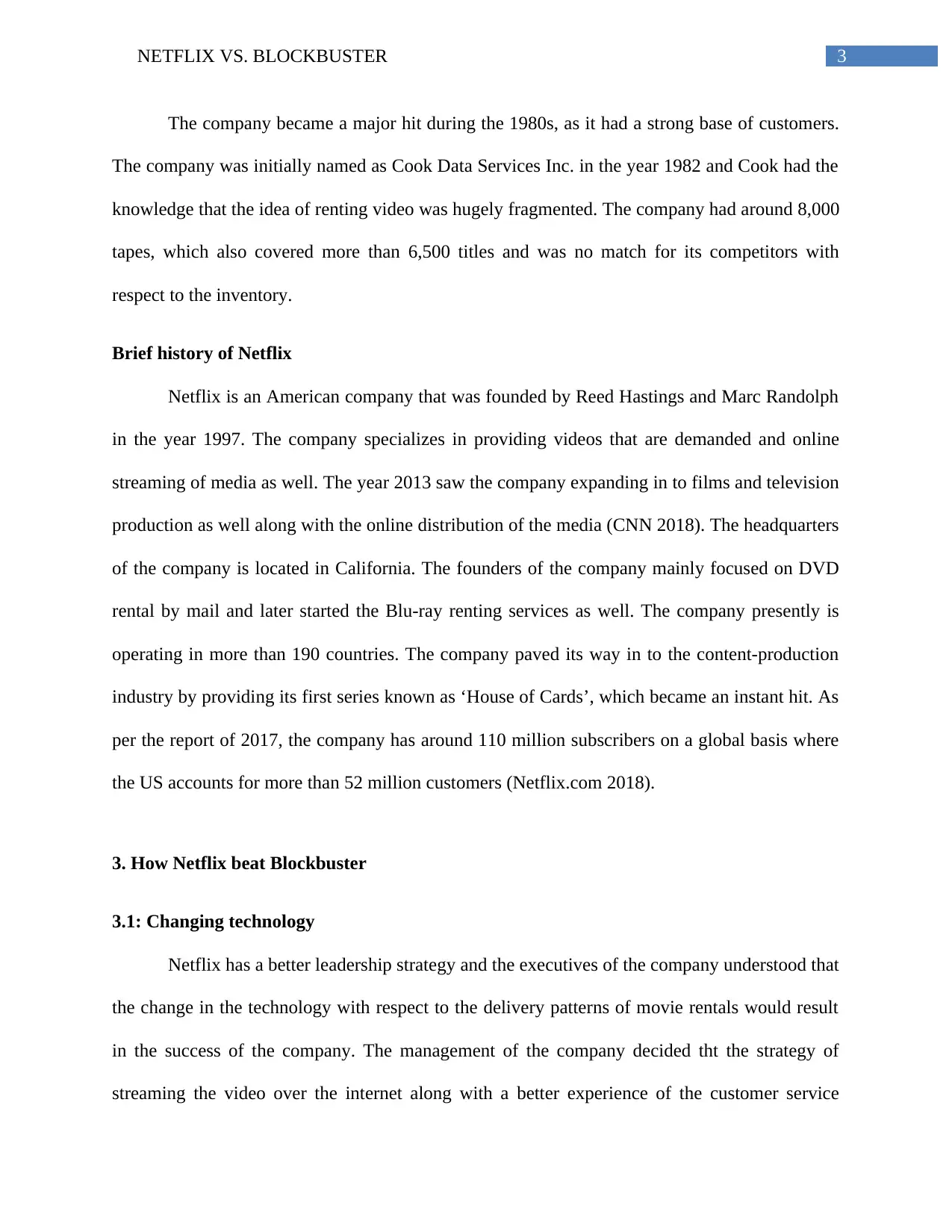
3NETFLIX VS. BLOCKBUSTER
The company became a major hit during the 1980s, as it had a strong base of customers.
The company was initially named as Cook Data Services Inc. in the year 1982 and Cook had the
knowledge that the idea of renting video was hugely fragmented. The company had around 8,000
tapes, which also covered more than 6,500 titles and was no match for its competitors with
respect to the inventory.
Brief history of Netflix
Netflix is an American company that was founded by Reed Hastings and Marc Randolph
in the year 1997. The company specializes in providing videos that are demanded and online
streaming of media as well. The year 2013 saw the company expanding in to films and television
production as well along with the online distribution of the media (CNN 2018). The headquarters
of the company is located in California. The founders of the company mainly focused on DVD
rental by mail and later started the Blu-ray renting services as well. The company presently is
operating in more than 190 countries. The company paved its way in to the content-production
industry by providing its first series known as ‘House of Cards’, which became an instant hit. As
per the report of 2017, the company has around 110 million subscribers on a global basis where
the US accounts for more than 52 million customers (Netflix.com 2018).
3. How Netflix beat Blockbuster
3.1: Changing technology
Netflix has a better leadership strategy and the executives of the company understood that
the change in the technology with respect to the delivery patterns of movie rentals would result
in the success of the company. The management of the company decided tht the strategy of
streaming the video over the internet along with a better experience of the customer service
The company became a major hit during the 1980s, as it had a strong base of customers.
The company was initially named as Cook Data Services Inc. in the year 1982 and Cook had the
knowledge that the idea of renting video was hugely fragmented. The company had around 8,000
tapes, which also covered more than 6,500 titles and was no match for its competitors with
respect to the inventory.
Brief history of Netflix
Netflix is an American company that was founded by Reed Hastings and Marc Randolph
in the year 1997. The company specializes in providing videos that are demanded and online
streaming of media as well. The year 2013 saw the company expanding in to films and television
production as well along with the online distribution of the media (CNN 2018). The headquarters
of the company is located in California. The founders of the company mainly focused on DVD
rental by mail and later started the Blu-ray renting services as well. The company presently is
operating in more than 190 countries. The company paved its way in to the content-production
industry by providing its first series known as ‘House of Cards’, which became an instant hit. As
per the report of 2017, the company has around 110 million subscribers on a global basis where
the US accounts for more than 52 million customers (Netflix.com 2018).
3. How Netflix beat Blockbuster
3.1: Changing technology
Netflix has a better leadership strategy and the executives of the company understood that
the change in the technology with respect to the delivery patterns of movie rentals would result
in the success of the company. The management of the company decided tht the strategy of
streaming the video over the internet along with a better experience of the customer service
Secure Best Marks with AI Grader
Need help grading? Try our AI Grader for instant feedback on your assignments.
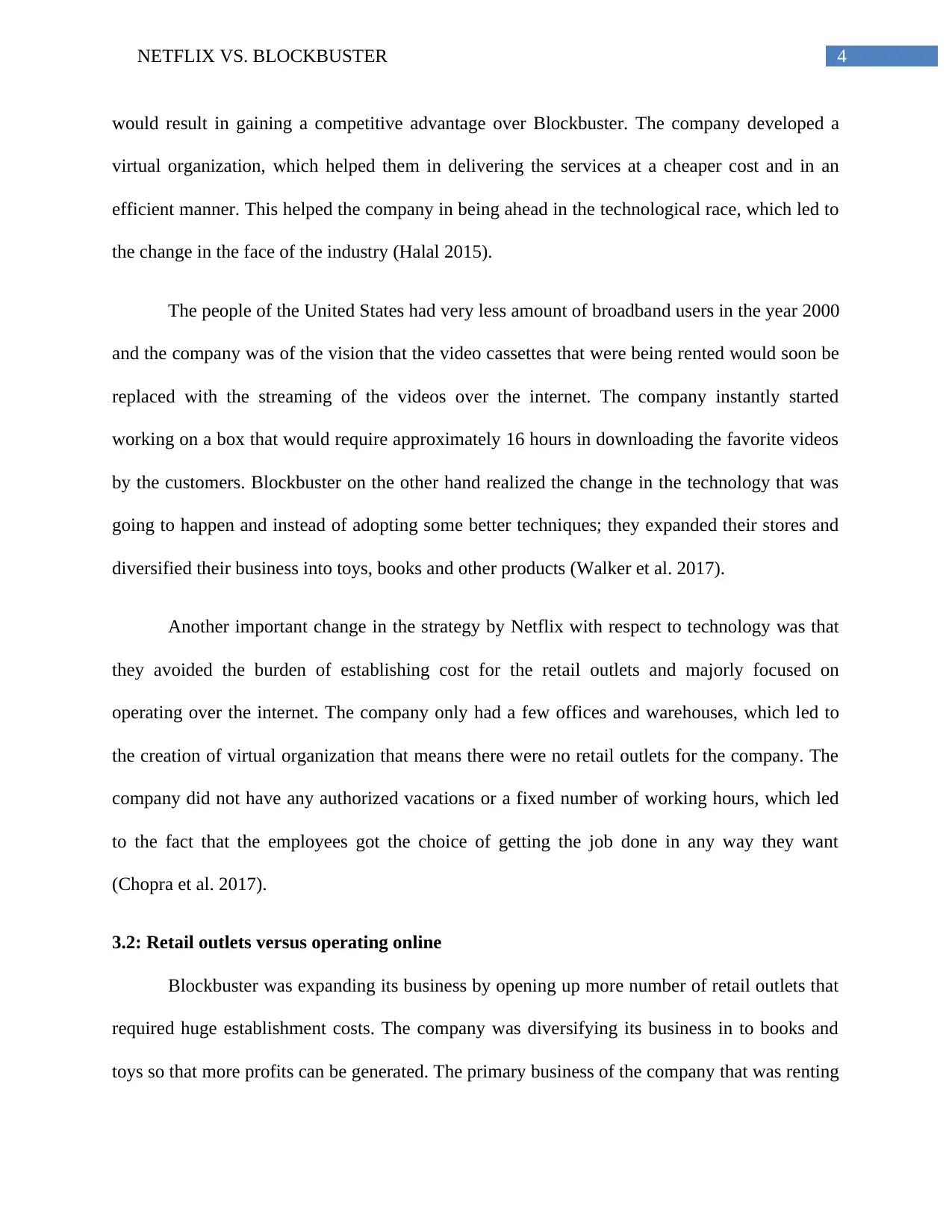
4NETFLIX VS. BLOCKBUSTER
would result in gaining a competitive advantage over Blockbuster. The company developed a
virtual organization, which helped them in delivering the services at a cheaper cost and in an
efficient manner. This helped the company in being ahead in the technological race, which led to
the change in the face of the industry (Halal 2015).
The people of the United States had very less amount of broadband users in the year 2000
and the company was of the vision that the video cassettes that were being rented would soon be
replaced with the streaming of the videos over the internet. The company instantly started
working on a box that would require approximately 16 hours in downloading the favorite videos
by the customers. Blockbuster on the other hand realized the change in the technology that was
going to happen and instead of adopting some better techniques; they expanded their stores and
diversified their business into toys, books and other products (Walker et al. 2017).
Another important change in the strategy by Netflix with respect to technology was that
they avoided the burden of establishing cost for the retail outlets and majorly focused on
operating over the internet. The company only had a few offices and warehouses, which led to
the creation of virtual organization that means there were no retail outlets for the company. The
company did not have any authorized vacations or a fixed number of working hours, which led
to the fact that the employees got the choice of getting the job done in any way they want
(Chopra et al. 2017).
3.2: Retail outlets versus operating online
Blockbuster was expanding its business by opening up more number of retail outlets that
required huge establishment costs. The company was diversifying its business in to books and
toys so that more profits can be generated. The primary business of the company that was renting
would result in gaining a competitive advantage over Blockbuster. The company developed a
virtual organization, which helped them in delivering the services at a cheaper cost and in an
efficient manner. This helped the company in being ahead in the technological race, which led to
the change in the face of the industry (Halal 2015).
The people of the United States had very less amount of broadband users in the year 2000
and the company was of the vision that the video cassettes that were being rented would soon be
replaced with the streaming of the videos over the internet. The company instantly started
working on a box that would require approximately 16 hours in downloading the favorite videos
by the customers. Blockbuster on the other hand realized the change in the technology that was
going to happen and instead of adopting some better techniques; they expanded their stores and
diversified their business into toys, books and other products (Walker et al. 2017).
Another important change in the strategy by Netflix with respect to technology was that
they avoided the burden of establishing cost for the retail outlets and majorly focused on
operating over the internet. The company only had a few offices and warehouses, which led to
the creation of virtual organization that means there were no retail outlets for the company. The
company did not have any authorized vacations or a fixed number of working hours, which led
to the fact that the employees got the choice of getting the job done in any way they want
(Chopra et al. 2017).
3.2: Retail outlets versus operating online
Blockbuster was expanding its business by opening up more number of retail outlets that
required huge establishment costs. The company was diversifying its business in to books and
toys so that more profits can be generated. The primary business of the company that was renting
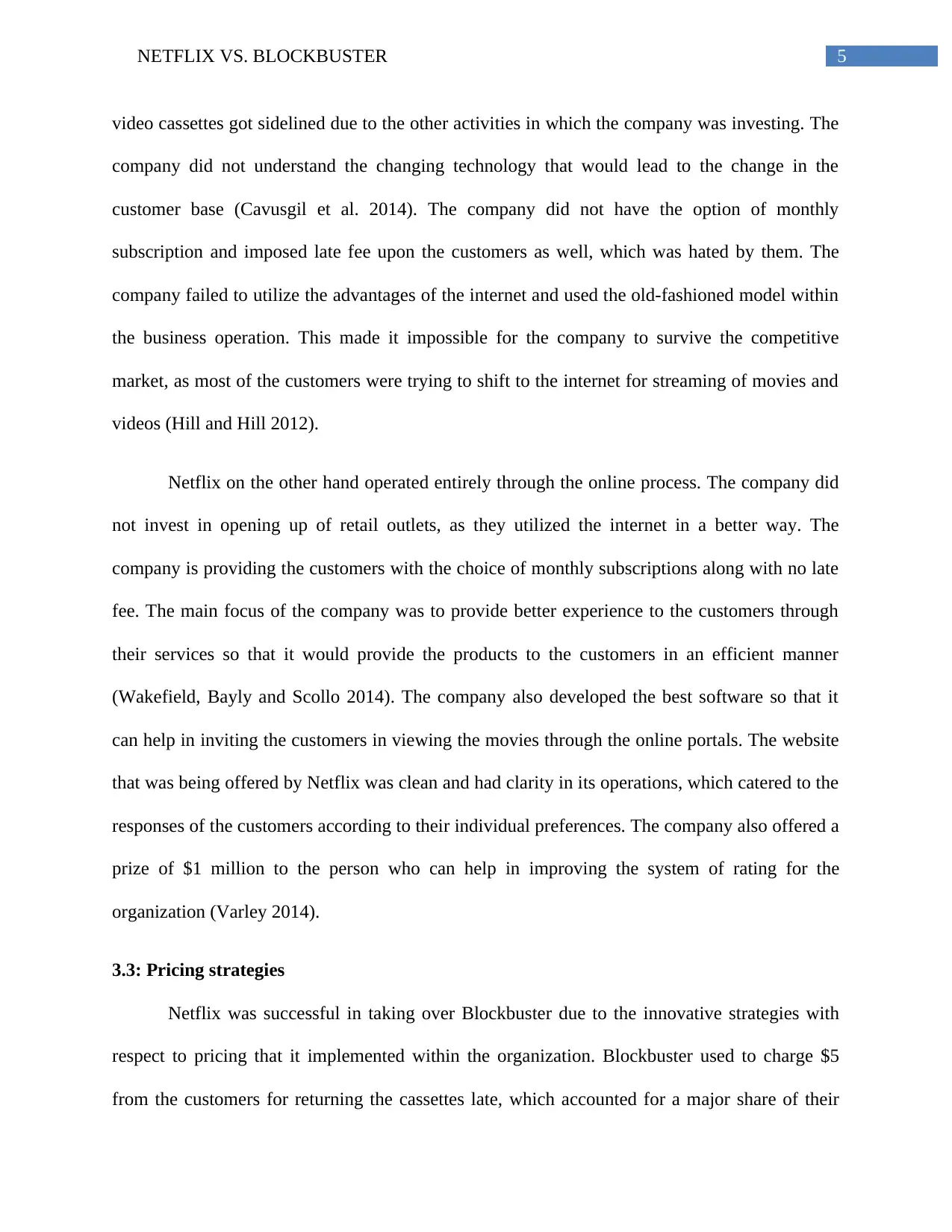
5NETFLIX VS. BLOCKBUSTER
video cassettes got sidelined due to the other activities in which the company was investing. The
company did not understand the changing technology that would lead to the change in the
customer base (Cavusgil et al. 2014). The company did not have the option of monthly
subscription and imposed late fee upon the customers as well, which was hated by them. The
company failed to utilize the advantages of the internet and used the old-fashioned model within
the business operation. This made it impossible for the company to survive the competitive
market, as most of the customers were trying to shift to the internet for streaming of movies and
videos (Hill and Hill 2012).
Netflix on the other hand operated entirely through the online process. The company did
not invest in opening up of retail outlets, as they utilized the internet in a better way. The
company is providing the customers with the choice of monthly subscriptions along with no late
fee. The main focus of the company was to provide better experience to the customers through
their services so that it would provide the products to the customers in an efficient manner
(Wakefield, Bayly and Scollo 2014). The company also developed the best software so that it
can help in inviting the customers in viewing the movies through the online portals. The website
that was being offered by Netflix was clean and had clarity in its operations, which catered to the
responses of the customers according to their individual preferences. The company also offered a
prize of $1 million to the person who can help in improving the system of rating for the
organization (Varley 2014).
3.3: Pricing strategies
Netflix was successful in taking over Blockbuster due to the innovative strategies with
respect to pricing that it implemented within the organization. Blockbuster used to charge $5
from the customers for returning the cassettes late, which accounted for a major share of their
video cassettes got sidelined due to the other activities in which the company was investing. The
company did not understand the changing technology that would lead to the change in the
customer base (Cavusgil et al. 2014). The company did not have the option of monthly
subscription and imposed late fee upon the customers as well, which was hated by them. The
company failed to utilize the advantages of the internet and used the old-fashioned model within
the business operation. This made it impossible for the company to survive the competitive
market, as most of the customers were trying to shift to the internet for streaming of movies and
videos (Hill and Hill 2012).
Netflix on the other hand operated entirely through the online process. The company did
not invest in opening up of retail outlets, as they utilized the internet in a better way. The
company is providing the customers with the choice of monthly subscriptions along with no late
fee. The main focus of the company was to provide better experience to the customers through
their services so that it would provide the products to the customers in an efficient manner
(Wakefield, Bayly and Scollo 2014). The company also developed the best software so that it
can help in inviting the customers in viewing the movies through the online portals. The website
that was being offered by Netflix was clean and had clarity in its operations, which catered to the
responses of the customers according to their individual preferences. The company also offered a
prize of $1 million to the person who can help in improving the system of rating for the
organization (Varley 2014).
3.3: Pricing strategies
Netflix was successful in taking over Blockbuster due to the innovative strategies with
respect to pricing that it implemented within the organization. Blockbuster used to charge $5
from the customers for returning the cassettes late, which accounted for a major share of their
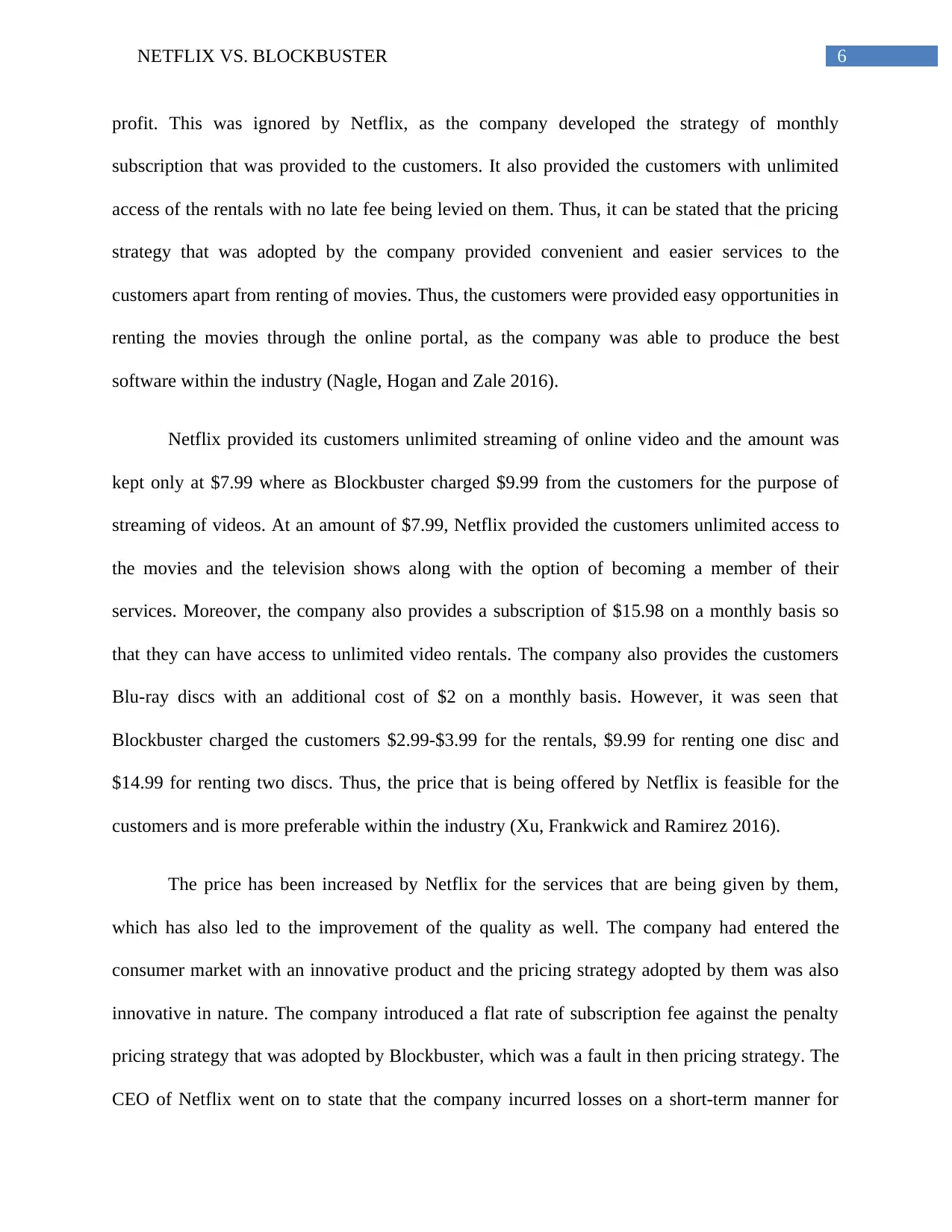
6NETFLIX VS. BLOCKBUSTER
profit. This was ignored by Netflix, as the company developed the strategy of monthly
subscription that was provided to the customers. It also provided the customers with unlimited
access of the rentals with no late fee being levied on them. Thus, it can be stated that the pricing
strategy that was adopted by the company provided convenient and easier services to the
customers apart from renting of movies. Thus, the customers were provided easy opportunities in
renting the movies through the online portal, as the company was able to produce the best
software within the industry (Nagle, Hogan and Zale 2016).
Netflix provided its customers unlimited streaming of online video and the amount was
kept only at $7.99 where as Blockbuster charged $9.99 from the customers for the purpose of
streaming of videos. At an amount of $7.99, Netflix provided the customers unlimited access to
the movies and the television shows along with the option of becoming a member of their
services. Moreover, the company also provides a subscription of $15.98 on a monthly basis so
that they can have access to unlimited video rentals. The company also provides the customers
Blu-ray discs with an additional cost of $2 on a monthly basis. However, it was seen that
Blockbuster charged the customers $2.99-$3.99 for the rentals, $9.99 for renting one disc and
$14.99 for renting two discs. Thus, the price that is being offered by Netflix is feasible for the
customers and is more preferable within the industry (Xu, Frankwick and Ramirez 2016).
The price has been increased by Netflix for the services that are being given by them,
which has also led to the improvement of the quality as well. The company had entered the
consumer market with an innovative product and the pricing strategy adopted by them was also
innovative in nature. The company introduced a flat rate of subscription fee against the penalty
pricing strategy that was adopted by Blockbuster, which was a fault in then pricing strategy. The
CEO of Netflix went on to state that the company incurred losses on a short-term manner for
profit. This was ignored by Netflix, as the company developed the strategy of monthly
subscription that was provided to the customers. It also provided the customers with unlimited
access of the rentals with no late fee being levied on them. Thus, it can be stated that the pricing
strategy that was adopted by the company provided convenient and easier services to the
customers apart from renting of movies. Thus, the customers were provided easy opportunities in
renting the movies through the online portal, as the company was able to produce the best
software within the industry (Nagle, Hogan and Zale 2016).
Netflix provided its customers unlimited streaming of online video and the amount was
kept only at $7.99 where as Blockbuster charged $9.99 from the customers for the purpose of
streaming of videos. At an amount of $7.99, Netflix provided the customers unlimited access to
the movies and the television shows along with the option of becoming a member of their
services. Moreover, the company also provides a subscription of $15.98 on a monthly basis so
that they can have access to unlimited video rentals. The company also provides the customers
Blu-ray discs with an additional cost of $2 on a monthly basis. However, it was seen that
Blockbuster charged the customers $2.99-$3.99 for the rentals, $9.99 for renting one disc and
$14.99 for renting two discs. Thus, the price that is being offered by Netflix is feasible for the
customers and is more preferable within the industry (Xu, Frankwick and Ramirez 2016).
The price has been increased by Netflix for the services that are being given by them,
which has also led to the improvement of the quality as well. The company had entered the
consumer market with an innovative product and the pricing strategy adopted by them was also
innovative in nature. The company introduced a flat rate of subscription fee against the penalty
pricing strategy that was adopted by Blockbuster, which was a fault in then pricing strategy. The
CEO of Netflix went on to state that the company incurred losses on a short-term manner for
Paraphrase This Document
Need a fresh take? Get an instant paraphrase of this document with our AI Paraphraser
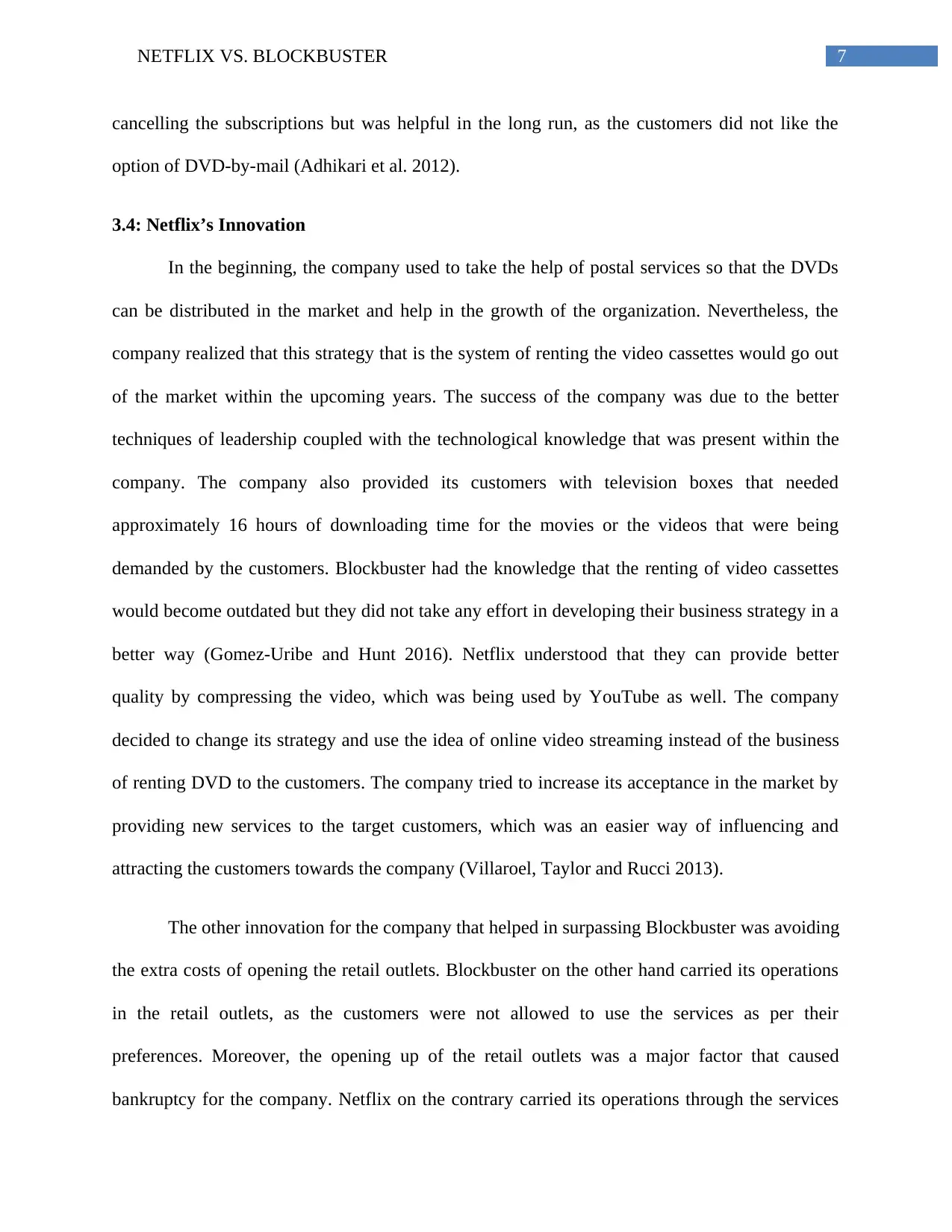
7NETFLIX VS. BLOCKBUSTER
cancelling the subscriptions but was helpful in the long run, as the customers did not like the
option of DVD-by-mail (Adhikari et al. 2012).
3.4: Netflix’s Innovation
In the beginning, the company used to take the help of postal services so that the DVDs
can be distributed in the market and help in the growth of the organization. Nevertheless, the
company realized that this strategy that is the system of renting the video cassettes would go out
of the market within the upcoming years. The success of the company was due to the better
techniques of leadership coupled with the technological knowledge that was present within the
company. The company also provided its customers with television boxes that needed
approximately 16 hours of downloading time for the movies or the videos that were being
demanded by the customers. Blockbuster had the knowledge that the renting of video cassettes
would become outdated but they did not take any effort in developing their business strategy in a
better way (Gomez-Uribe and Hunt 2016). Netflix understood that they can provide better
quality by compressing the video, which was being used by YouTube as well. The company
decided to change its strategy and use the idea of online video streaming instead of the business
of renting DVD to the customers. The company tried to increase its acceptance in the market by
providing new services to the target customers, which was an easier way of influencing and
attracting the customers towards the company (Villaroel, Taylor and Rucci 2013).
The other innovation for the company that helped in surpassing Blockbuster was avoiding
the extra costs of opening the retail outlets. Blockbuster on the other hand carried its operations
in the retail outlets, as the customers were not allowed to use the services as per their
preferences. Moreover, the opening up of the retail outlets was a major factor that caused
bankruptcy for the company. Netflix on the contrary carried its operations through the services
cancelling the subscriptions but was helpful in the long run, as the customers did not like the
option of DVD-by-mail (Adhikari et al. 2012).
3.4: Netflix’s Innovation
In the beginning, the company used to take the help of postal services so that the DVDs
can be distributed in the market and help in the growth of the organization. Nevertheless, the
company realized that this strategy that is the system of renting the video cassettes would go out
of the market within the upcoming years. The success of the company was due to the better
techniques of leadership coupled with the technological knowledge that was present within the
company. The company also provided its customers with television boxes that needed
approximately 16 hours of downloading time for the movies or the videos that were being
demanded by the customers. Blockbuster had the knowledge that the renting of video cassettes
would become outdated but they did not take any effort in developing their business strategy in a
better way (Gomez-Uribe and Hunt 2016). Netflix understood that they can provide better
quality by compressing the video, which was being used by YouTube as well. The company
decided to change its strategy and use the idea of online video streaming instead of the business
of renting DVD to the customers. The company tried to increase its acceptance in the market by
providing new services to the target customers, which was an easier way of influencing and
attracting the customers towards the company (Villaroel, Taylor and Rucci 2013).
The other innovation for the company that helped in surpassing Blockbuster was avoiding
the extra costs of opening the retail outlets. Blockbuster on the other hand carried its operations
in the retail outlets, as the customers were not allowed to use the services as per their
preferences. Moreover, the opening up of the retail outlets was a major factor that caused
bankruptcy for the company. Netflix on the contrary carried its operations through the services
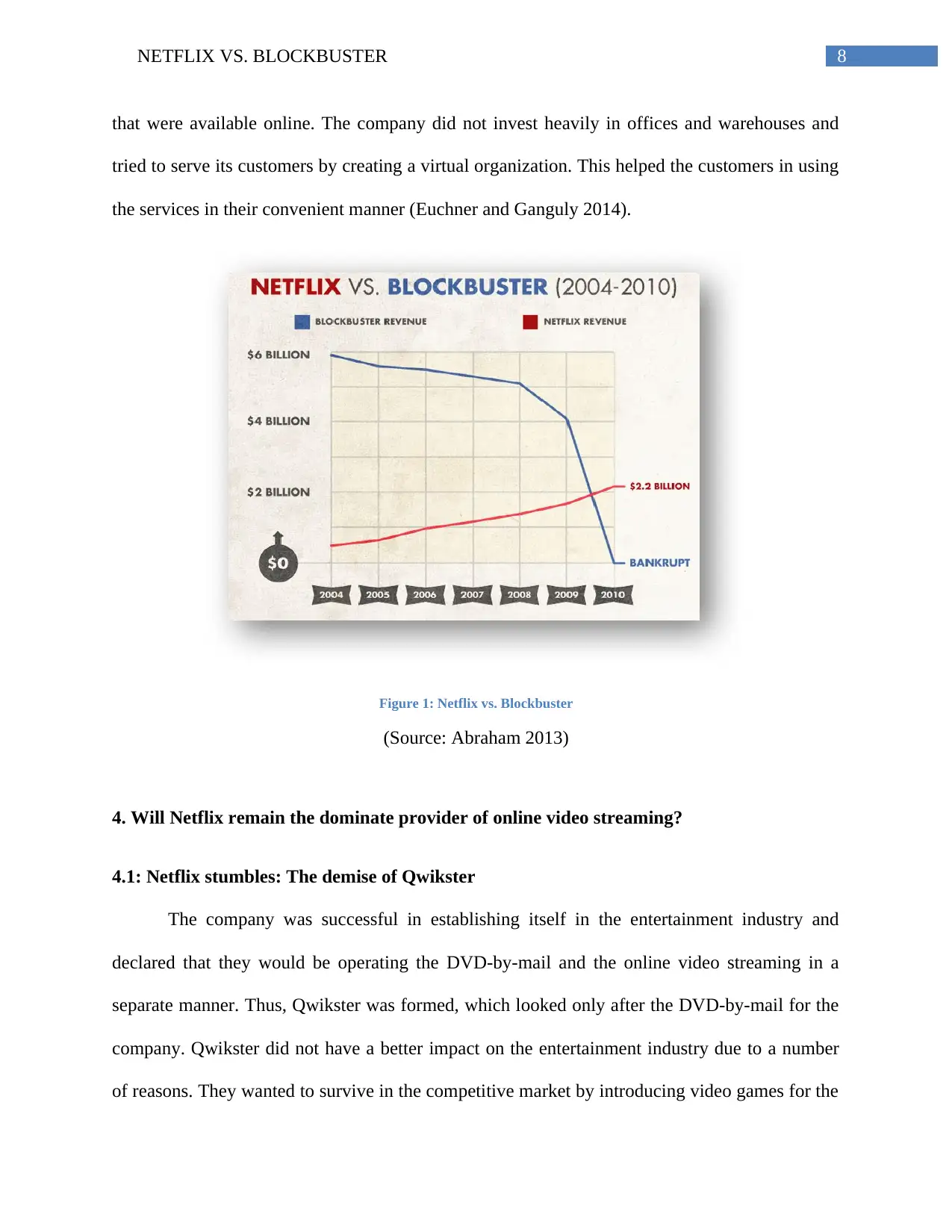
8NETFLIX VS. BLOCKBUSTER
that were available online. The company did not invest heavily in offices and warehouses and
tried to serve its customers by creating a virtual organization. This helped the customers in using
the services in their convenient manner (Euchner and Ganguly 2014).
Figure 1: Netflix vs. Blockbuster
(Source: Abraham 2013)
4. Will Netflix remain the dominate provider of online video streaming?
4.1: Netflix stumbles: The demise of Qwikster
The company was successful in establishing itself in the entertainment industry and
declared that they would be operating the DVD-by-mail and the online video streaming in a
separate manner. Thus, Qwikster was formed, which looked only after the DVD-by-mail for the
company. Qwikster did not have a better impact on the entertainment industry due to a number
of reasons. They wanted to survive in the competitive market by introducing video games for the
that were available online. The company did not invest heavily in offices and warehouses and
tried to serve its customers by creating a virtual organization. This helped the customers in using
the services in their convenient manner (Euchner and Ganguly 2014).
Figure 1: Netflix vs. Blockbuster
(Source: Abraham 2013)
4. Will Netflix remain the dominate provider of online video streaming?
4.1: Netflix stumbles: The demise of Qwikster
The company was successful in establishing itself in the entertainment industry and
declared that they would be operating the DVD-by-mail and the online video streaming in a
separate manner. Thus, Qwikster was formed, which looked only after the DVD-by-mail for the
company. Qwikster did not have a better impact on the entertainment industry due to a number
of reasons. They wanted to survive in the competitive market by introducing video games for the
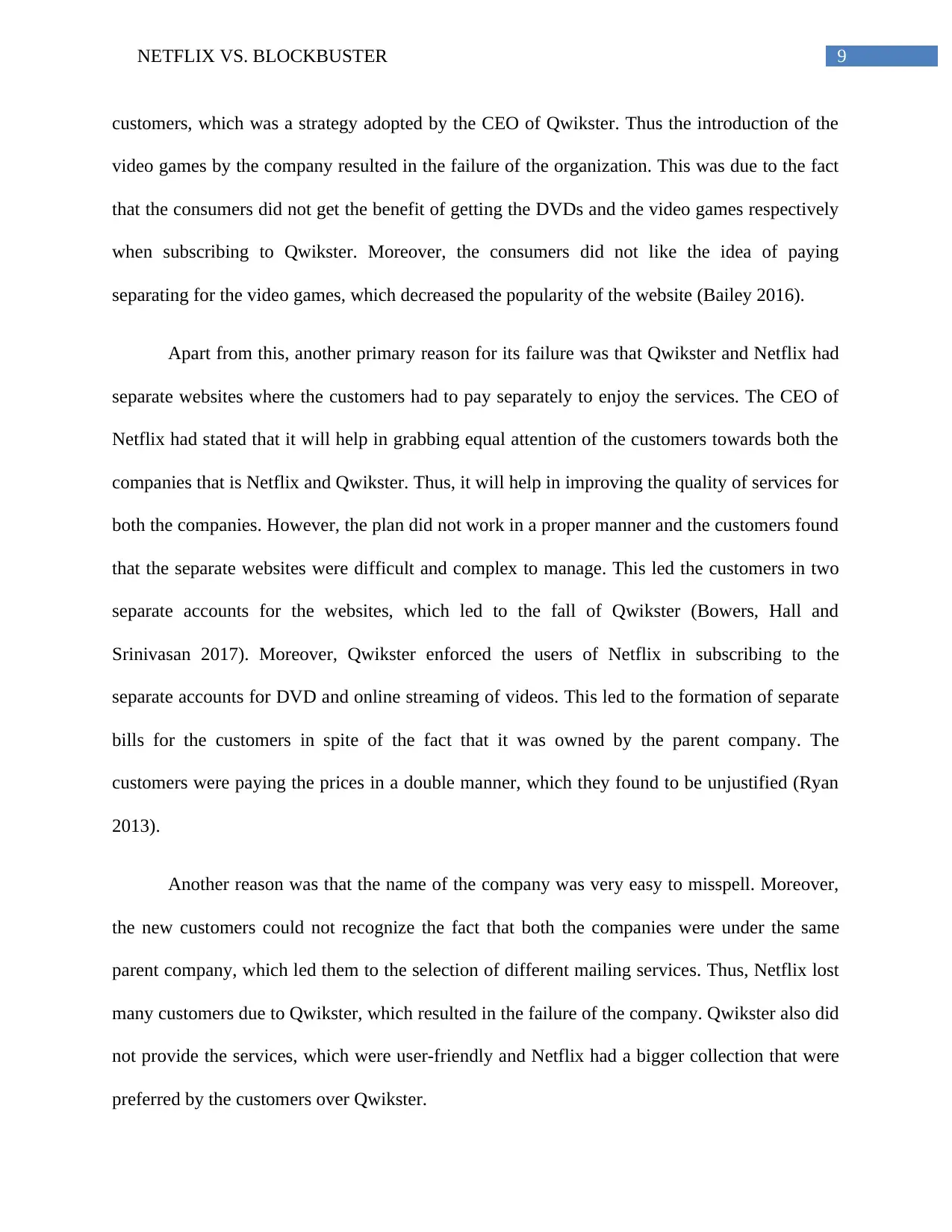
9NETFLIX VS. BLOCKBUSTER
customers, which was a strategy adopted by the CEO of Qwikster. Thus the introduction of the
video games by the company resulted in the failure of the organization. This was due to the fact
that the consumers did not get the benefit of getting the DVDs and the video games respectively
when subscribing to Qwikster. Moreover, the consumers did not like the idea of paying
separating for the video games, which decreased the popularity of the website (Bailey 2016).
Apart from this, another primary reason for its failure was that Qwikster and Netflix had
separate websites where the customers had to pay separately to enjoy the services. The CEO of
Netflix had stated that it will help in grabbing equal attention of the customers towards both the
companies that is Netflix and Qwikster. Thus, it will help in improving the quality of services for
both the companies. However, the plan did not work in a proper manner and the customers found
that the separate websites were difficult and complex to manage. This led the customers in two
separate accounts for the websites, which led to the fall of Qwikster (Bowers, Hall and
Srinivasan 2017). Moreover, Qwikster enforced the users of Netflix in subscribing to the
separate accounts for DVD and online streaming of videos. This led to the formation of separate
bills for the customers in spite of the fact that it was owned by the parent company. The
customers were paying the prices in a double manner, which they found to be unjustified (Ryan
2013).
Another reason was that the name of the company was very easy to misspell. Moreover,
the new customers could not recognize the fact that both the companies were under the same
parent company, which led them to the selection of different mailing services. Thus, Netflix lost
many customers due to Qwikster, which resulted in the failure of the company. Qwikster also did
not provide the services, which were user-friendly and Netflix had a bigger collection that were
preferred by the customers over Qwikster.
customers, which was a strategy adopted by the CEO of Qwikster. Thus the introduction of the
video games by the company resulted in the failure of the organization. This was due to the fact
that the consumers did not get the benefit of getting the DVDs and the video games respectively
when subscribing to Qwikster. Moreover, the consumers did not like the idea of paying
separating for the video games, which decreased the popularity of the website (Bailey 2016).
Apart from this, another primary reason for its failure was that Qwikster and Netflix had
separate websites where the customers had to pay separately to enjoy the services. The CEO of
Netflix had stated that it will help in grabbing equal attention of the customers towards both the
companies that is Netflix and Qwikster. Thus, it will help in improving the quality of services for
both the companies. However, the plan did not work in a proper manner and the customers found
that the separate websites were difficult and complex to manage. This led the customers in two
separate accounts for the websites, which led to the fall of Qwikster (Bowers, Hall and
Srinivasan 2017). Moreover, Qwikster enforced the users of Netflix in subscribing to the
separate accounts for DVD and online streaming of videos. This led to the formation of separate
bills for the customers in spite of the fact that it was owned by the parent company. The
customers were paying the prices in a double manner, which they found to be unjustified (Ryan
2013).
Another reason was that the name of the company was very easy to misspell. Moreover,
the new customers could not recognize the fact that both the companies were under the same
parent company, which led them to the selection of different mailing services. Thus, Netflix lost
many customers due to Qwikster, which resulted in the failure of the company. Qwikster also did
not provide the services, which were user-friendly and Netflix had a bigger collection that were
preferred by the customers over Qwikster.
Secure Best Marks with AI Grader
Need help grading? Try our AI Grader for instant feedback on your assignments.
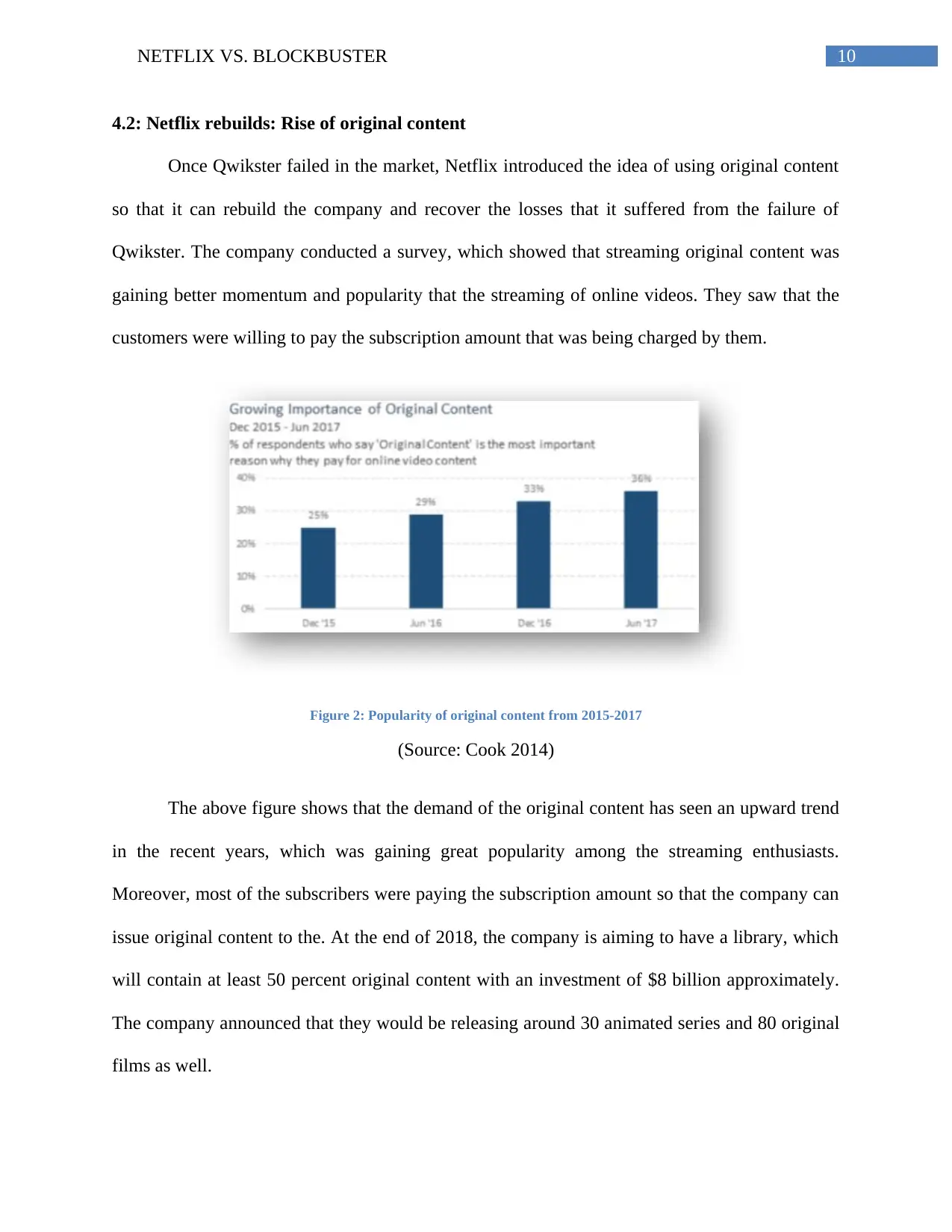
10NETFLIX VS. BLOCKBUSTER
4.2: Netflix rebuilds: Rise of original content
Once Qwikster failed in the market, Netflix introduced the idea of using original content
so that it can rebuild the company and recover the losses that it suffered from the failure of
Qwikster. The company conducted a survey, which showed that streaming original content was
gaining better momentum and popularity that the streaming of online videos. They saw that the
customers were willing to pay the subscription amount that was being charged by them.
Figure 2: Popularity of original content from 2015-2017
(Source: Cook 2014)
The above figure shows that the demand of the original content has seen an upward trend
in the recent years, which was gaining great popularity among the streaming enthusiasts.
Moreover, most of the subscribers were paying the subscription amount so that the company can
issue original content to the. At the end of 2018, the company is aiming to have a library, which
will contain at least 50 percent original content with an investment of $8 billion approximately.
The company announced that they would be releasing around 30 animated series and 80 original
films as well.
4.2: Netflix rebuilds: Rise of original content
Once Qwikster failed in the market, Netflix introduced the idea of using original content
so that it can rebuild the company and recover the losses that it suffered from the failure of
Qwikster. The company conducted a survey, which showed that streaming original content was
gaining better momentum and popularity that the streaming of online videos. They saw that the
customers were willing to pay the subscription amount that was being charged by them.
Figure 2: Popularity of original content from 2015-2017
(Source: Cook 2014)
The above figure shows that the demand of the original content has seen an upward trend
in the recent years, which was gaining great popularity among the streaming enthusiasts.
Moreover, most of the subscribers were paying the subscription amount so that the company can
issue original content to the. At the end of 2018, the company is aiming to have a library, which
will contain at least 50 percent original content with an investment of $8 billion approximately.
The company announced that they would be releasing around 30 animated series and 80 original
films as well.

11NETFLIX VS. BLOCKBUSTER
Figure 3: Netflix vs. Amazon original content
(Source: Michalis 2014)
The figure shows that most of the customers prefer the original content that was provided
by Netflix over Amazon. After the successful entry with original content in 2013, the company
gained a competitive advantage over the rivals that were present in the market. an example of
this would be that the company made original series like ‘House of Cards’ and ‘Orange is the
New Black’, which made it easy for the company to gain more subscriptions from the customers.
Thus, the introduction of original content by the company helped them in rebuilding the
company and be sustainable in the market.
4.3: Future of Netflix
The online streaming of videos is the future of television, which highlights the future of
the company to be bright. There are immense opportunities for the company in improving its
range for streaming of videos and content. The company also puts more emphasis in the
production of original content, which is being demanded by the customers to a great extent. The
CEO of the company has went on to state that the use of linear television will be replaced by
Figure 3: Netflix vs. Amazon original content
(Source: Michalis 2014)
The figure shows that most of the customers prefer the original content that was provided
by Netflix over Amazon. After the successful entry with original content in 2013, the company
gained a competitive advantage over the rivals that were present in the market. an example of
this would be that the company made original series like ‘House of Cards’ and ‘Orange is the
New Black’, which made it easy for the company to gain more subscriptions from the customers.
Thus, the introduction of original content by the company helped them in rebuilding the
company and be sustainable in the market.
4.3: Future of Netflix
The online streaming of videos is the future of television, which highlights the future of
the company to be bright. There are immense opportunities for the company in improving its
range for streaming of videos and content. The company also puts more emphasis in the
production of original content, which is being demanded by the customers to a great extent. The
CEO of the company has went on to state that the use of linear television will be replaced by
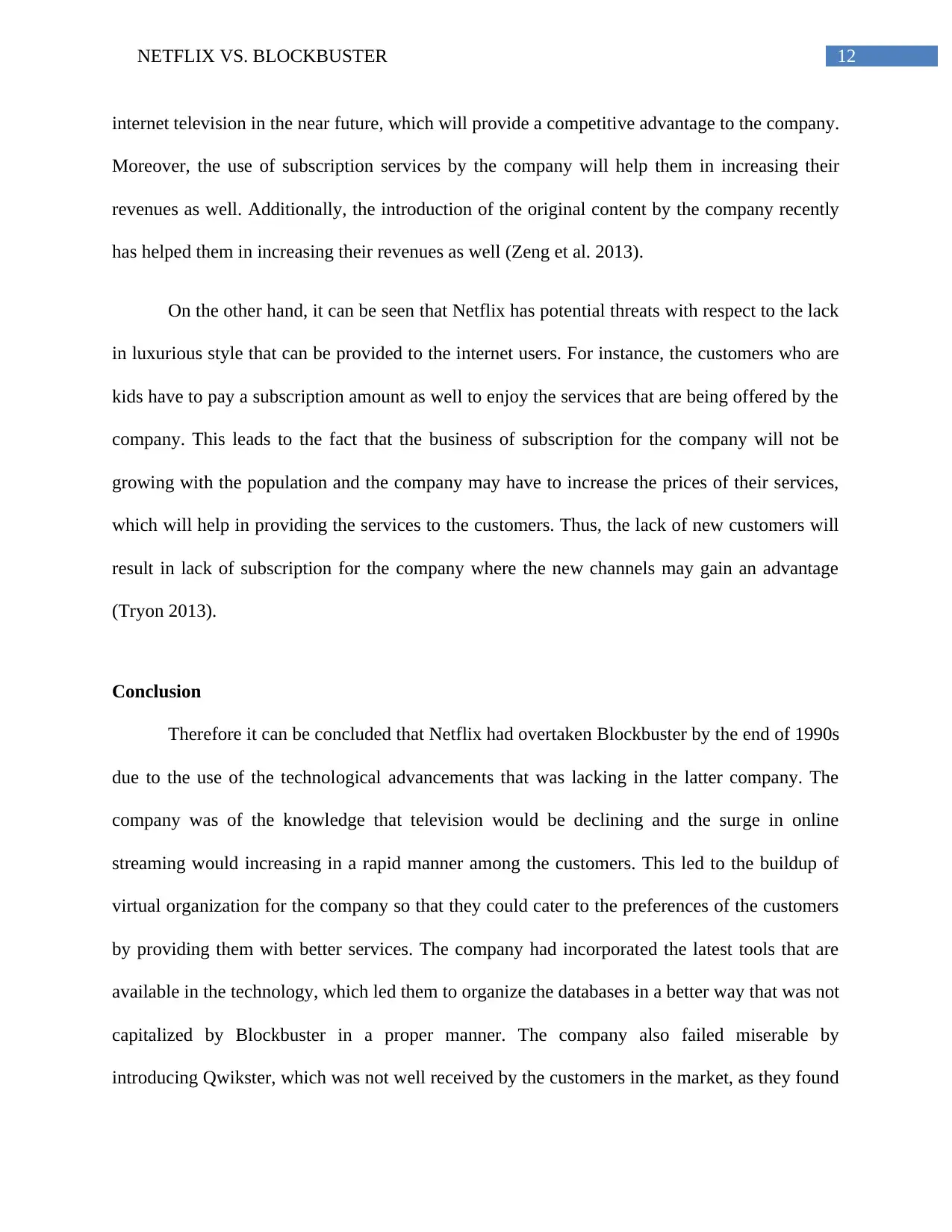
12NETFLIX VS. BLOCKBUSTER
internet television in the near future, which will provide a competitive advantage to the company.
Moreover, the use of subscription services by the company will help them in increasing their
revenues as well. Additionally, the introduction of the original content by the company recently
has helped them in increasing their revenues as well (Zeng et al. 2013).
On the other hand, it can be seen that Netflix has potential threats with respect to the lack
in luxurious style that can be provided to the internet users. For instance, the customers who are
kids have to pay a subscription amount as well to enjoy the services that are being offered by the
company. This leads to the fact that the business of subscription for the company will not be
growing with the population and the company may have to increase the prices of their services,
which will help in providing the services to the customers. Thus, the lack of new customers will
result in lack of subscription for the company where the new channels may gain an advantage
(Tryon 2013).
Conclusion
Therefore it can be concluded that Netflix had overtaken Blockbuster by the end of 1990s
due to the use of the technological advancements that was lacking in the latter company. The
company was of the knowledge that television would be declining and the surge in online
streaming would increasing in a rapid manner among the customers. This led to the buildup of
virtual organization for the company so that they could cater to the preferences of the customers
by providing them with better services. The company had incorporated the latest tools that are
available in the technology, which led them to organize the databases in a better way that was not
capitalized by Blockbuster in a proper manner. The company also failed miserable by
introducing Qwikster, which was not well received by the customers in the market, as they found
internet television in the near future, which will provide a competitive advantage to the company.
Moreover, the use of subscription services by the company will help them in increasing their
revenues as well. Additionally, the introduction of the original content by the company recently
has helped them in increasing their revenues as well (Zeng et al. 2013).
On the other hand, it can be seen that Netflix has potential threats with respect to the lack
in luxurious style that can be provided to the internet users. For instance, the customers who are
kids have to pay a subscription amount as well to enjoy the services that are being offered by the
company. This leads to the fact that the business of subscription for the company will not be
growing with the population and the company may have to increase the prices of their services,
which will help in providing the services to the customers. Thus, the lack of new customers will
result in lack of subscription for the company where the new channels may gain an advantage
(Tryon 2013).
Conclusion
Therefore it can be concluded that Netflix had overtaken Blockbuster by the end of 1990s
due to the use of the technological advancements that was lacking in the latter company. The
company was of the knowledge that television would be declining and the surge in online
streaming would increasing in a rapid manner among the customers. This led to the buildup of
virtual organization for the company so that they could cater to the preferences of the customers
by providing them with better services. The company had incorporated the latest tools that are
available in the technology, which led them to organize the databases in a better way that was not
capitalized by Blockbuster in a proper manner. The company also failed miserable by
introducing Qwikster, which was not well received by the customers in the market, as they found
Paraphrase This Document
Need a fresh take? Get an instant paraphrase of this document with our AI Paraphraser

13NETFLIX VS. BLOCKBUSTER
it confusing in maintaining two separate accounts. This led the company in rebuilding
themselves by introducing original content under their banner, which was widely accepted by the
users.
it confusing in maintaining two separate accounts. This led the company in rebuilding
themselves by introducing original content under their banner, which was widely accepted by the
users.
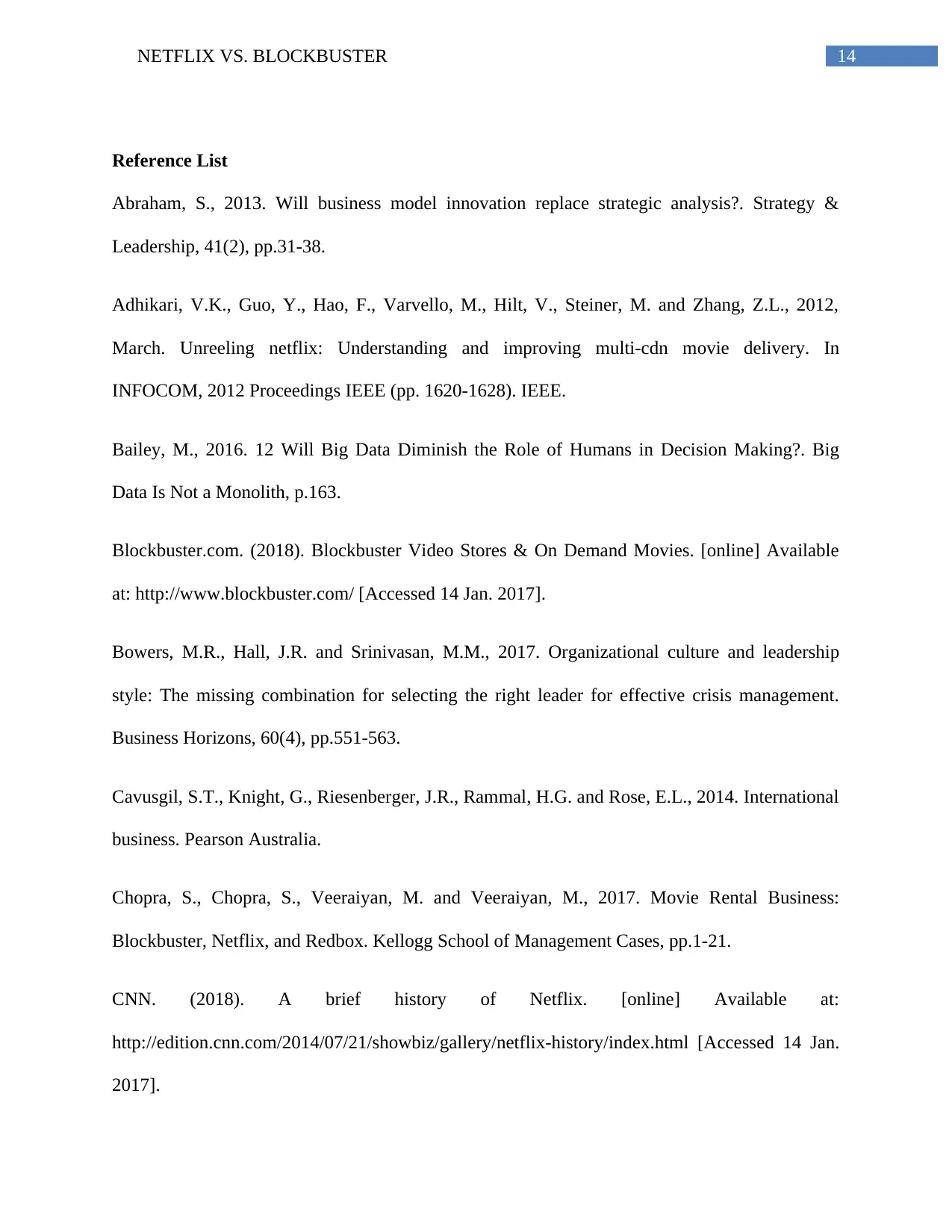
14NETFLIX VS. BLOCKBUSTER
Reference List
Abraham, S., 2013. Will business model innovation replace strategic analysis?. Strategy &
Leadership, 41(2), pp.31-38.
Adhikari, V.K., Guo, Y., Hao, F., Varvello, M., Hilt, V., Steiner, M. and Zhang, Z.L., 2012,
March. Unreeling netflix: Understanding and improving multi-cdn movie delivery. In
INFOCOM, 2012 Proceedings IEEE (pp. 1620-1628). IEEE.
Bailey, M., 2016. 12 Will Big Data Diminish the Role of Humans in Decision Making?. Big
Data Is Not a Monolith, p.163.
Blockbuster.com. (2018). Blockbuster Video Stores & On Demand Movies. [online] Available
at: http://www.blockbuster.com/ [Accessed 14 Jan. 2017].
Bowers, M.R., Hall, J.R. and Srinivasan, M.M., 2017. Organizational culture and leadership
style: The missing combination for selecting the right leader for effective crisis management.
Business Horizons, 60(4), pp.551-563.
Cavusgil, S.T., Knight, G., Riesenberger, J.R., Rammal, H.G. and Rose, E.L., 2014. International
business. Pearson Australia.
Chopra, S., Chopra, S., Veeraiyan, M. and Veeraiyan, M., 2017. Movie Rental Business:
Blockbuster, Netflix, and Redbox. Kellogg School of Management Cases, pp.1-21.
CNN. (2018). A brief history of Netflix. [online] Available at:
http://edition.cnn.com/2014/07/21/showbiz/gallery/netflix-history/index.html [Accessed 14 Jan.
2017].
Reference List
Abraham, S., 2013. Will business model innovation replace strategic analysis?. Strategy &
Leadership, 41(2), pp.31-38.
Adhikari, V.K., Guo, Y., Hao, F., Varvello, M., Hilt, V., Steiner, M. and Zhang, Z.L., 2012,
March. Unreeling netflix: Understanding and improving multi-cdn movie delivery. In
INFOCOM, 2012 Proceedings IEEE (pp. 1620-1628). IEEE.
Bailey, M., 2016. 12 Will Big Data Diminish the Role of Humans in Decision Making?. Big
Data Is Not a Monolith, p.163.
Blockbuster.com. (2018). Blockbuster Video Stores & On Demand Movies. [online] Available
at: http://www.blockbuster.com/ [Accessed 14 Jan. 2017].
Bowers, M.R., Hall, J.R. and Srinivasan, M.M., 2017. Organizational culture and leadership
style: The missing combination for selecting the right leader for effective crisis management.
Business Horizons, 60(4), pp.551-563.
Cavusgil, S.T., Knight, G., Riesenberger, J.R., Rammal, H.G. and Rose, E.L., 2014. International
business. Pearson Australia.
Chopra, S., Chopra, S., Veeraiyan, M. and Veeraiyan, M., 2017. Movie Rental Business:
Blockbuster, Netflix, and Redbox. Kellogg School of Management Cases, pp.1-21.
CNN. (2018). A brief history of Netflix. [online] Available at:
http://edition.cnn.com/2014/07/21/showbiz/gallery/netflix-history/index.html [Accessed 14 Jan.
2017].
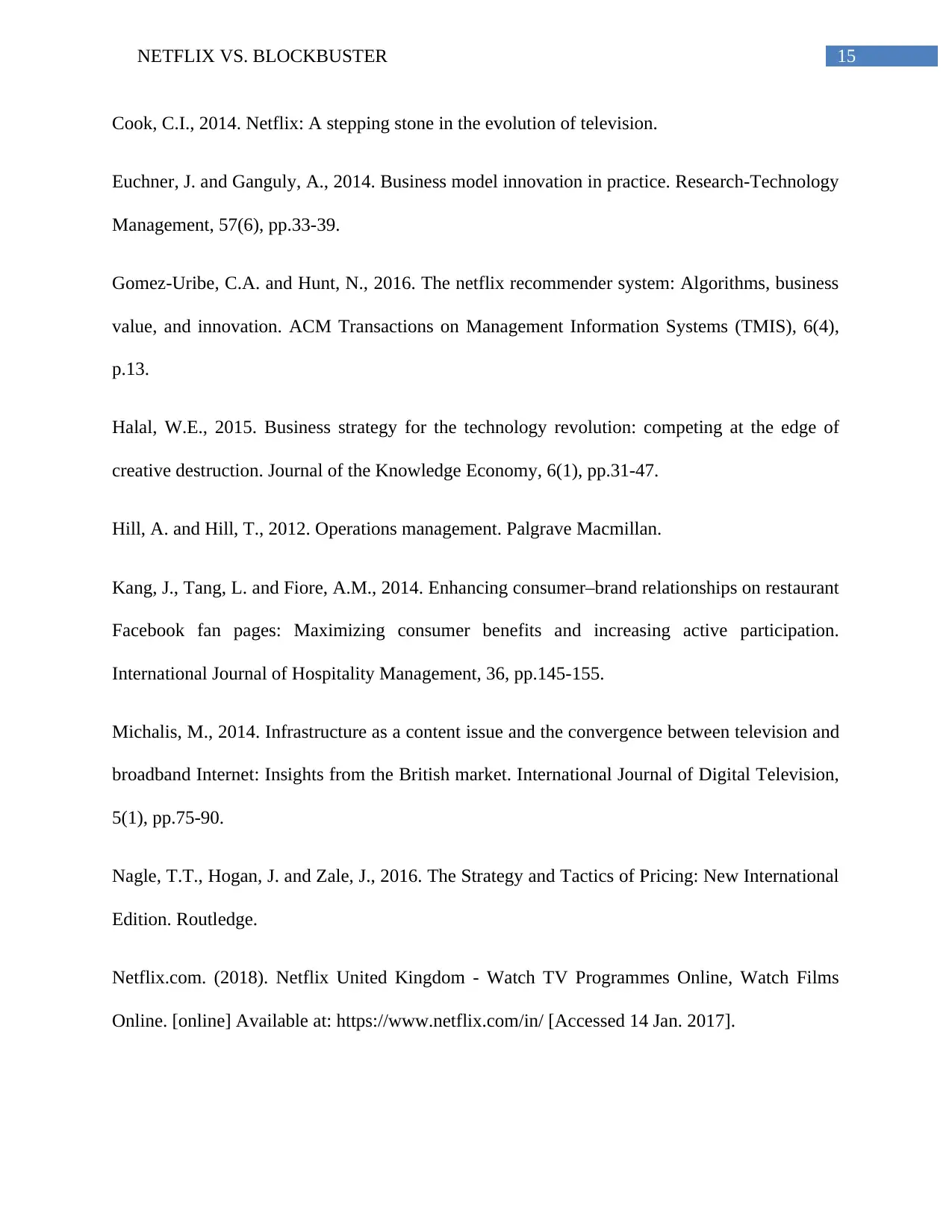
15NETFLIX VS. BLOCKBUSTER
Cook, C.I., 2014. Netflix: A stepping stone in the evolution of television.
Euchner, J. and Ganguly, A., 2014. Business model innovation in practice. Research-Technology
Management, 57(6), pp.33-39.
Gomez-Uribe, C.A. and Hunt, N., 2016. The netflix recommender system: Algorithms, business
value, and innovation. ACM Transactions on Management Information Systems (TMIS), 6(4),
p.13.
Halal, W.E., 2015. Business strategy for the technology revolution: competing at the edge of
creative destruction. Journal of the Knowledge Economy, 6(1), pp.31-47.
Hill, A. and Hill, T., 2012. Operations management. Palgrave Macmillan.
Kang, J., Tang, L. and Fiore, A.M., 2014. Enhancing consumer–brand relationships on restaurant
Facebook fan pages: Maximizing consumer benefits and increasing active participation.
International Journal of Hospitality Management, 36, pp.145-155.
Michalis, M., 2014. Infrastructure as a content issue and the convergence between television and
broadband Internet: Insights from the British market. International Journal of Digital Television,
5(1), pp.75-90.
Nagle, T.T., Hogan, J. and Zale, J., 2016. The Strategy and Tactics of Pricing: New International
Edition. Routledge.
Netflix.com. (2018). Netflix United Kingdom - Watch TV Programmes Online, Watch Films
Online. [online] Available at: https://www.netflix.com/in/ [Accessed 14 Jan. 2017].
Cook, C.I., 2014. Netflix: A stepping stone in the evolution of television.
Euchner, J. and Ganguly, A., 2014. Business model innovation in practice. Research-Technology
Management, 57(6), pp.33-39.
Gomez-Uribe, C.A. and Hunt, N., 2016. The netflix recommender system: Algorithms, business
value, and innovation. ACM Transactions on Management Information Systems (TMIS), 6(4),
p.13.
Halal, W.E., 2015. Business strategy for the technology revolution: competing at the edge of
creative destruction. Journal of the Knowledge Economy, 6(1), pp.31-47.
Hill, A. and Hill, T., 2012. Operations management. Palgrave Macmillan.
Kang, J., Tang, L. and Fiore, A.M., 2014. Enhancing consumer–brand relationships on restaurant
Facebook fan pages: Maximizing consumer benefits and increasing active participation.
International Journal of Hospitality Management, 36, pp.145-155.
Michalis, M., 2014. Infrastructure as a content issue and the convergence between television and
broadband Internet: Insights from the British market. International Journal of Digital Television,
5(1), pp.75-90.
Nagle, T.T., Hogan, J. and Zale, J., 2016. The Strategy and Tactics of Pricing: New International
Edition. Routledge.
Netflix.com. (2018). Netflix United Kingdom - Watch TV Programmes Online, Watch Films
Online. [online] Available at: https://www.netflix.com/in/ [Accessed 14 Jan. 2017].
Secure Best Marks with AI Grader
Need help grading? Try our AI Grader for instant feedback on your assignments.
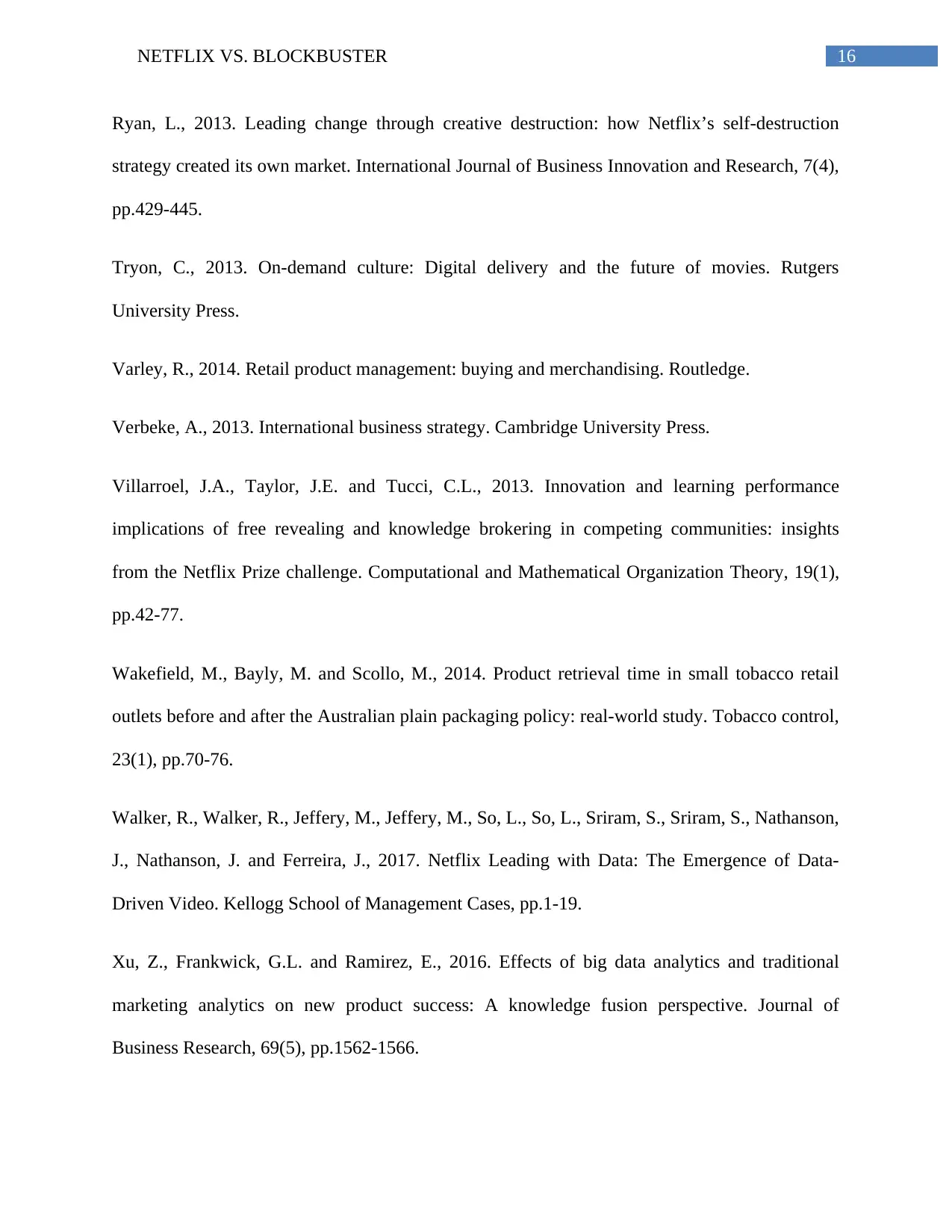
16NETFLIX VS. BLOCKBUSTER
Ryan, L., 2013. Leading change through creative destruction: how Netflix’s self-destruction
strategy created its own market. International Journal of Business Innovation and Research, 7(4),
pp.429-445.
Tryon, C., 2013. On-demand culture: Digital delivery and the future of movies. Rutgers
University Press.
Varley, R., 2014. Retail product management: buying and merchandising. Routledge.
Verbeke, A., 2013. International business strategy. Cambridge University Press.
Villarroel, J.A., Taylor, J.E. and Tucci, C.L., 2013. Innovation and learning performance
implications of free revealing and knowledge brokering in competing communities: insights
from the Netflix Prize challenge. Computational and Mathematical Organization Theory, 19(1),
pp.42-77.
Wakefield, M., Bayly, M. and Scollo, M., 2014. Product retrieval time in small tobacco retail
outlets before and after the Australian plain packaging policy: real-world study. Tobacco control,
23(1), pp.70-76.
Walker, R., Walker, R., Jeffery, M., Jeffery, M., So, L., So, L., Sriram, S., Sriram, S., Nathanson,
J., Nathanson, J. and Ferreira, J., 2017. Netflix Leading with Data: The Emergence of Data-
Driven Video. Kellogg School of Management Cases, pp.1-19.
Xu, Z., Frankwick, G.L. and Ramirez, E., 2016. Effects of big data analytics and traditional
marketing analytics on new product success: A knowledge fusion perspective. Journal of
Business Research, 69(5), pp.1562-1566.
Ryan, L., 2013. Leading change through creative destruction: how Netflix’s self-destruction
strategy created its own market. International Journal of Business Innovation and Research, 7(4),
pp.429-445.
Tryon, C., 2013. On-demand culture: Digital delivery and the future of movies. Rutgers
University Press.
Varley, R., 2014. Retail product management: buying and merchandising. Routledge.
Verbeke, A., 2013. International business strategy. Cambridge University Press.
Villarroel, J.A., Taylor, J.E. and Tucci, C.L., 2013. Innovation and learning performance
implications of free revealing and knowledge brokering in competing communities: insights
from the Netflix Prize challenge. Computational and Mathematical Organization Theory, 19(1),
pp.42-77.
Wakefield, M., Bayly, M. and Scollo, M., 2014. Product retrieval time in small tobacco retail
outlets before and after the Australian plain packaging policy: real-world study. Tobacco control,
23(1), pp.70-76.
Walker, R., Walker, R., Jeffery, M., Jeffery, M., So, L., So, L., Sriram, S., Sriram, S., Nathanson,
J., Nathanson, J. and Ferreira, J., 2017. Netflix Leading with Data: The Emergence of Data-
Driven Video. Kellogg School of Management Cases, pp.1-19.
Xu, Z., Frankwick, G.L. and Ramirez, E., 2016. Effects of big data analytics and traditional
marketing analytics on new product success: A knowledge fusion perspective. Journal of
Business Research, 69(5), pp.1562-1566.

17NETFLIX VS. BLOCKBUSTER
Zeng, A., Gualdi, S., Medo, M. and Zhang, Y.C., 2013. Trend prediction in temporal bipartite
networks: the case of movielens, netflix, and digg. Advances in Complex Systems, 16(04n05),
p.1350024.
Zeng, A., Gualdi, S., Medo, M. and Zhang, Y.C., 2013. Trend prediction in temporal bipartite
networks: the case of movielens, netflix, and digg. Advances in Complex Systems, 16(04n05),
p.1350024.
1 out of 18
Your All-in-One AI-Powered Toolkit for Academic Success.
+13062052269
info@desklib.com
Available 24*7 on WhatsApp / Email
![[object Object]](/_next/static/media/star-bottom.7253800d.svg)
Unlock your academic potential
© 2024 | Zucol Services PVT LTD | All rights reserved.





